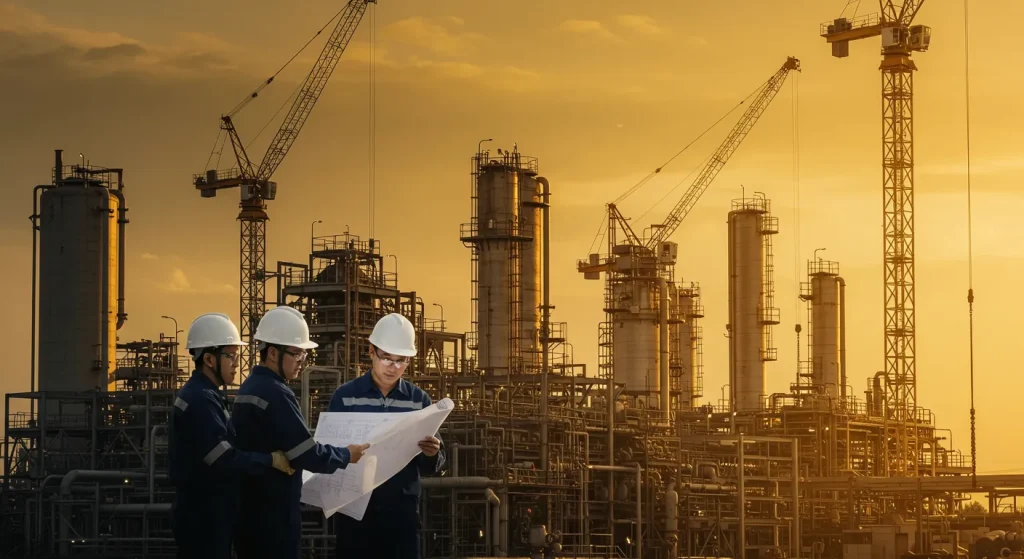
## The Art and Science of Fabricating Production and Test Separators: Ensuring Efficient and Accurate Fluid Separation
Production and test separators are essential components in the oil and gas industry, playing a crucial role in separating well fluids (oil, gas, and water) into their constituent phases. Their efficient and accurate operation is paramount for optimizing production, ensuring accurate measurement, and protecting downstream equipment. This article delves into the fabrication process of these critical vessels, highlighting the key considerations and methodologies involved in creating robust and reliable separators.
**Understanding the Importance of Quality Fabrication**
The performance of a production or test separator is directly linked to the quality of its fabrication. A well-fabricated separator offers several advantages:
* **Optimal Separation Efficiency:** Proper internal design and construction ensure efficient phase separation, maximizing oil recovery and minimizing contamination.
* **Accurate Measurement:** Precise fabrication and calibration contribute to accurate measurement of individual fluid phases, crucial for production accounting and royalty calculations.
* **Enhanced Safety:** Robust construction and adherence to industry standards minimize the risk of leaks, failures, and potential environmental incidents.
* **Extended Lifespan:** Quality materials and fabrication techniques ensure the separator can withstand harsh operating conditions and maintain its integrity over the long term.
* **Reduced Maintenance:** Properly fabricated separators require less frequent maintenance and repairs, minimizing downtime and operational costs.
**The Fabrication Process: A Step-by-Step Overview**
The fabrication of production and test separators typically involves the following key stages:
**1. Design and Engineering:**
* **Process Simulation:** The process begins with a detailed process simulation to determine the optimal separator size, configuration, and internal design based on the expected well fluid composition, flow rates, operating pressure, and temperature.
* **Mechanical Design:** Engineers design the vessel according to industry standards (e.g., ASME Section VIII Division 1) and client specifications, considering factors such as wall thickness, nozzle placement, support structures, and safety features.
* **Detailed Drawings:** Comprehensive fabrication drawings are generated, providing precise instructions for each stage of the manufacturing process.
**2. Material Selection:**
* **Carbon Steel:** Commonly used for general applications due to its cost-effectiveness and weldability.
* **Alloy Steel:** Employed for high-pressure, high-temperature, or corrosive environments.
* **Stainless Steel:** Selected for applications requiring resistance to corrosion and erosion.
* **Coatings and Linings:** Internal coatings or linings are often applied to protect the vessel from corrosion and erosion caused by aggressive well fluids.
**3. Cutting and Forming:**
* **Plate Cutting:** Steel plates are cut to the required dimensions using automated cutting machines such as plasma or laser cutters.
* **Shell Rolling:** Plates are formed into cylindrical or spherical shells using rolling machines.
* **Head Forming:** Heads (end caps) are formed using hydraulic presses or spinning techniques.
**4. Welding and Assembly:**
* **Welding Procedures:** Qualified welders utilize approved welding procedures to join the shell sections, heads, nozzles, and other components.
* **Welding Inspection:** Rigorous inspection methods, including visual inspection, radiographic testing, ultrasonic testing, and magnetic particle testing, are employed to ensure weld integrity and detect any defects.
* **Internal Installation:** Internal components such as baffles, weirs, mist extractors, and liquid level controllers are installed according to the design specifications.
**5. Non-Destructive Testing (NDT):**
* **Radiography:** Used to detect internal flaws in welds and base metal.
* **Ultrasonic Testing:** Employs sound waves to detect surface and subsurface defects.
* **Magnetic Particle Testing:** Detects surface and near-surface cracks in ferromagnetic materials.
* **Liquid Penetrant Testing:** Reveals surface cracks and discontinuities.
**6. Hydrostatic Testing:**
* **Pressure Testing:** The completed vessel is subjected to a hydrostatic test to verify its structural integrity and leak tightness. The vessel is filled with water and pressurized to a predetermined test pressure, typically 1.5 times the design pressure.
**7. Surface Preparation and Coating:**
* **Sandblasting:** The vessel’s exterior is sandblasted to remove mill scale, rust, and other contaminants, providing a clean surface for coating.
* **Coating Application:** Protective coatings, such as epoxy or polyurethane, are applied to the exterior surface to prevent corrosion.
**8. Instrumentation and Controls:**
* **Installation:** Instruments such as pressure transmitters, level transmitters, temperature sensors, and control valves are installed.
* **Calibration:** Instruments are calibrated to ensure accurate measurement and control.
**9. Inspection and Quality Control:**
* **Third-Party Inspection:** Independent inspection agencies are often involved to verify compliance with industry standards and client specifications.
* **Documentation:** Comprehensive documentation, including material certificates, welding records, NDT reports, and hydrostatic test reports, is compiled and maintained.
**Challenges and Considerations in Fabrication:**
* **Welding Dissimilar Metals:** Joining different types of metals (e.g., carbon steel to stainless steel) requires specialized welding procedures and filler metals.
* **Corrosion Resistance:** Selecting appropriate materials and coatings to withstand the corrosive nature of well fluids is crucial.
* **High-Pressure Applications:** Fabricating separators for high-pressure applications requires careful attention to design, material selection, and welding procedures.
* **Tight Tolerances:** Achieving tight tolerances in fabrication is essential for proper operation of internal components and accurate measurement.
* **Logistics and Transportation:** The size and weight of separators can pose logistical challenges during transportation and installation.
**Emerging Technologies and Innovations:**
* **Advanced Welding Techniques:** Friction stir welding and laser welding are being explored to improve weld quality and reduce welding time.
* **Additive Manufacturing (3D Printing):** 3D printing is being used to fabricate complex internal components with improved performance characteristics.
* **Digitalization and Automation:** Digitalization and automation are being implemented to improve efficiency and accuracy throughout the fabrication process.
**Conclusion:**
The fabrication of production and test separators is a complex process that requires specialized expertise, meticulous attention to detail, and adherence to stringent quality standards. By understanding the key stages involved and addressing the challenges associated with fabrication, manufacturers can produce robust and reliable separators that contribute to efficient and accurate fluid separation, ultimately optimizing oil and gas production. As technology continues to evolve, innovations in welding techniques, materials science, and automation will further enhance the fabrication process, leading to even more efficient and reliable separators in the future.